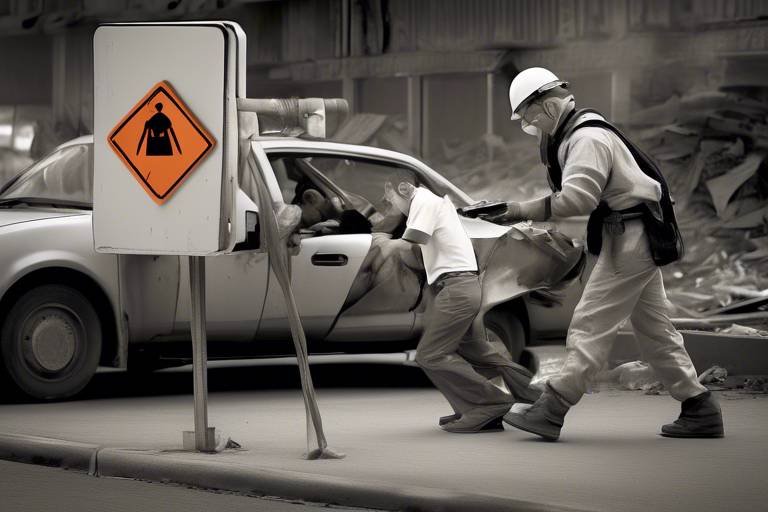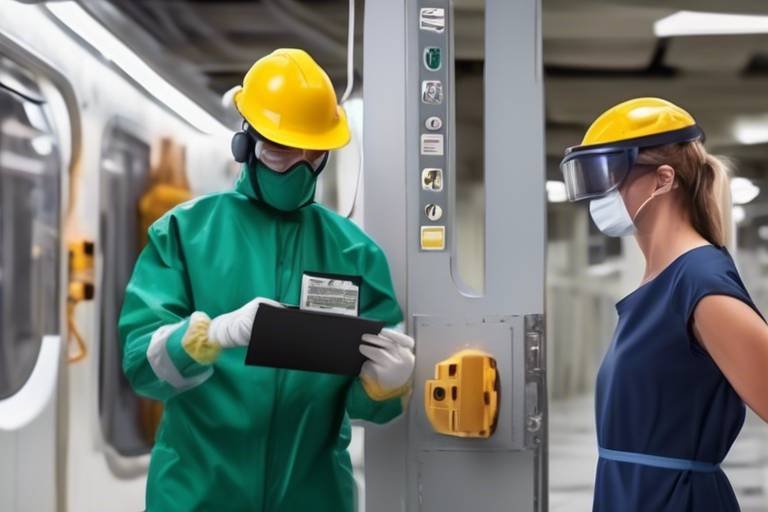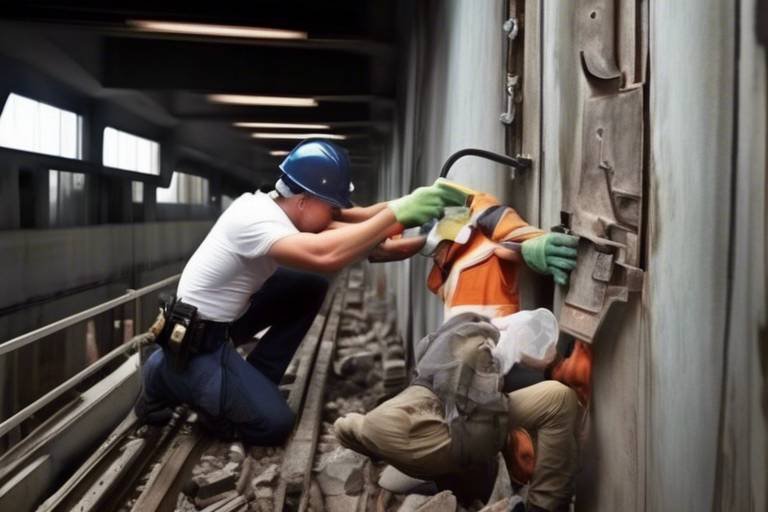Human Behavior and Safety Measures: Exploring the Connection
In today's world, the intricate relationship between human behavior and safety measures is more critical than ever. As we navigate through various environments—be it at work, home, or while engaging in recreational activities—understanding how our actions and decisions impact safety protocols can lead to a significant reduction in accidents and injuries. By delving into the psychological factors that drive our behaviors, we can create more effective safety measures that resonate with individuals on a deeper level.
Imagine a workplace where every employee is not just aware of safety protocols but actively participates in fostering a culture of safety. This is not a distant dream; it is a tangible goal that can be achieved by understanding the psychology of risk perception. People often have varying perceptions of risk based on their experiences, knowledge, and even emotions. For instance, a seasoned worker may underestimate the risks of a task they’ve performed countless times, while a newcomer might overestimate the dangers due to a lack of experience. This disparity highlights the need for tailored safety measures that consider these psychological nuances.
Furthermore, the role of human factors cannot be overlooked. Ergonomics and cognitive psychology play a pivotal role in shaping our work environments. When we design workspaces that align with human capabilities and limitations, we not only enhance productivity but also reduce the likelihood of errors that can lead to accidents. For example, a well-designed workstation can minimize physical strain, thereby allowing employees to focus on their tasks without the distraction of discomfort. This leads to a safer and more efficient workplace.
To effectively change workplace culture, organizations can implement behavioral safety programs. These programs focus on encouraging safe behaviors through positive reinforcement and active participation. By fostering a proactive safety mindset, employees are more likely to adopt safe practices as a part of their daily routines. This cultural shift can be achieved through various strategies, including regular training sessions, safety audits, and recognition of individuals who exemplify safe behaviors.
Regular training and awareness initiatives are vital for reinforcing safe practices. Continuous education ensures that employees are up-to-date with the latest safety protocols and understand the importance of their roles in maintaining a safe environment. This ongoing commitment to safety not only empowers employees but also cultivates a sense of responsibility towards their own well-being and that of their colleagues.
In addition to training, establishing feedback mechanisms is crucial. By providing employees with a platform to report unsafe conditions, organizations can address potential hazards before they escalate into serious incidents. Open communication fosters a culture of transparency and trust, where employees feel valued and heard. This proactive approach to safety can significantly enhance the overall safety climate within an organization.
Another vital aspect to consider is the influence of social dynamics on safety behavior. Peer influence and group norms can significantly affect individual compliance with safety measures. When employees observe their colleagues adhering to safety protocols, they are more likely to follow suit. Conversely, if unsafe behaviors are normalized within a group, it can lead to a cascade of risky actions. Therefore, promoting a strong safety culture at all levels of an organization is essential for ensuring that safety is a shared value.
As we explore the connection between human behavior and safety measures, we cannot ignore the impact of technology. Advancements in technology have the potential to enhance safety measures in unprecedented ways. Tools and applications designed to monitor and promote safety can influence human behavior positively. For instance, wearable safety devices are revolutionizing workplace safety by providing real-time data on health and safety metrics. These devices empower employees to take charge of their safety by alerting them to potential hazards before they become critical.
Furthermore, the use of data analytics can help organizations identify patterns in safety incidents. By analyzing data, companies can gain insights into common risk factors and develop targeted strategies to mitigate these risks. This proactive approach not only improves safety outcomes but also fosters a culture of continuous improvement within the organization.
- What are behavioral safety programs?
Behavioral safety programs focus on changing workplace culture by encouraging safe behaviors through positive reinforcement and active participation.
- How can technology improve safety measures?
Technology, such as wearable safety devices and data analytics, can monitor safety metrics and identify patterns in incidents, enhancing overall safety strategies.
- Why is training important for safety?
Regular training ensures employees are informed about the latest safety protocols and reinforces the importance of their role in maintaining a safe environment.

The Psychology of Risk Perception
Understanding how individuals perceive risk is crucial for developing effective safety measures. Risk perception is not merely about the actual danger present; it’s heavily influenced by psychological factors that vary from person to person. For instance, some people may view a task as highly risky due to past experiences or inherent fears, while others might see it as a routine part of their job. This discrepancy can lead to significant differences in how safety protocols are followed or ignored.
One of the primary psychological factors influencing risk perception is cognitive bias. Cognitive biases can warp our understanding of risk, leading us to either overestimate or underestimate the dangers of a situation. For example, the availability heuristic causes individuals to judge the likelihood of events based on how easily examples come to mind. If someone has recently heard about a workplace accident, they might perceive their own work environment as more dangerous, even if statistics suggest otherwise.
Moreover, emotional responses can dramatically shape our risk assessments. Fear, for instance, can trigger a heightened perception of risk, causing individuals to act cautiously or even irrationally. On the flip side, overconfidence can lead to a dangerous underestimation of risks. This emotional interplay is essential to consider when designing safety measures, as it highlights the need for strategies that address both rational assessments and emotional responses.
To illustrate this further, consider the following factors that can influence risk perception:
- Personal Experience: Past experiences can create a lens through which we view potential risks. Someone who has experienced a near-miss in a workplace accident may be more vigilant than someone who has never faced such a scenario.
- Social Influences: The opinions and behaviors of peers can significantly impact individual risk perception. If a group of colleagues downplays safety concerns, an individual may feel pressured to conform.
- Media Influence: Coverage of accidents and disasters can skew public perception of risk, often leading to heightened fear of unlikely events.
Incorporating an understanding of these psychological factors into safety protocols can lead to more effective strategies. For instance, organizations can conduct workshops that not only inform employees about safety measures but also address the emotional and cognitive aspects of risk perception. By fostering an environment where employees feel safe to express their concerns and experiences, organizations can enhance overall safety culture.
Ultimately, recognizing that risk perception is a complex interplay of cognitive biases, emotions, and social influences is vital for creating a safer workplace. By tailoring safety measures to account for these psychological factors, organizations can better equip their employees to navigate risks effectively, leading to a more proactive and engaged safety culture.
- What is risk perception?
Risk perception refers to the subjective judgment people make about the characteristics and severity of a risk. - How do cognitive biases affect safety?
Cognitive biases can distort an individual's perception of risk, leading to either overestimation or underestimation of dangers in their environment. - Why is understanding psychology important for safety measures?
Understanding psychology helps in designing safety protocols that resonate with employees, making them more likely to adhere to safety practices.

The Role of Human Factors in Safety
When we think about safety, it’s easy to get lost in the technical aspects—like protocols, equipment, and regulations. But here’s the kicker: human factors play a pivotal role in determining how effective those safety measures really are. Imagine a well-oiled machine; every gear has its place, and if one gear falters, the whole system can break down. Similarly, understanding human behavior and cognitive processes is essential for creating environments where safety thrives.
One of the key components of human factors is ergonomics, which focuses on designing workplaces that fit the needs of the workers. Think about it: if a workstation is uncomfortable or poorly designed, employees are more likely to make mistakes, which can lead to accidents. For instance, if a factory worker is constantly straining to reach tools, their focus may wane, increasing the risk of injury. By optimizing the workspace, we can significantly enhance safety outcomes. A well-designed environment not only boosts productivity but also minimizes the likelihood of errors that could lead to hazardous situations.
Another crucial aspect is cognitive psychology. This field examines how people process information, make decisions, and react to their surroundings. In high-pressure situations, such as emergency response or construction sites, individuals often rely on instinct rather than a thorough assessment of risks. Understanding how stress and fatigue affect decision-making can help organizations implement better safety protocols. For example, if workers are trained to recognize signs of fatigue and know when to take breaks, they can maintain a higher level of awareness, reducing the chances of accidents.
Behavioral safety programs are a practical application of these principles. These programs aim to foster a culture where safety is everyone’s responsibility. By encouraging safe behaviors through positive reinforcement and recognition, organizations can shift mindsets from reactive to proactive. For example, when employees see their peers being rewarded for following safety protocols, they are more likely to adopt those behaviors themselves. It’s like a ripple effect—one small change can lead to a wave of positive outcomes.
To truly make a difference, organizations must also prioritize training and awareness. Regular workshops and refresher courses can keep safety at the forefront of employees’ minds. Imagine a fire drill; it’s not just about knowing where the exits are, but also about understanding the importance of staying calm and following procedures. Continuous education helps reinforce safe practices and keeps everyone on the same page, making it easier to navigate potentially dangerous situations.
Lastly, establishing feedback mechanisms is essential for enhancing safety. When employees feel empowered to report unsafe conditions without fear of retribution, it creates an environment of open communication. This not only helps in identifying hazards but also addresses behavioral issues promptly. For example, if a worker notices a colleague bypassing safety protocols, they should feel comfortable discussing it. This open dialogue can lead to immediate corrective actions, preventing accidents before they happen.
In conclusion, the role of human factors in safety is multifaceted and cannot be overlooked. By focusing on ergonomics, cognitive psychology, behavioral safety, training, and feedback, organizations can create safer work environments that prioritize the well-being of their employees. After all, safety isn’t just about rules and regulations; it’s about understanding the people who are at the heart of every safety measure.
- What are human factors in safety? Human factors refer to the psychological, social, and physical aspects that influence how individuals behave in relation to safety protocols.
- Why is ergonomics important for safety? Ergonomics helps design workspaces that accommodate workers’ needs, reducing the risk of injuries and enhancing overall productivity.
- How do behavioral safety programs work? These programs encourage safe behaviors through positive reinforcement, fostering a culture of safety within the organization.
- What role does training play in safety? Regular training helps reinforce safe practices and keeps safety awareness high among employees.
- How can feedback mechanisms improve safety? Feedback mechanisms allow employees to report unsafe conditions, promoting open communication and timely resolutions to potential hazards.

Implementing behavioral safety programs is not just a trend; it's a necessity for organizations that prioritize the well-being of their employees. These programs aim to cultivate a culture where safety is not just a set of rules but a core value that everyone embraces. Imagine walking into a workplace where every individual feels responsible for their own safety and that of their colleagues. This is the essence of behavioral safety—it's about creating an environment where safety is second nature.
One of the most effective strategies to encourage safe behaviors is through active participation. Employees should not feel like safety measures are being imposed on them; instead, they should be involved in the creation and implementation of these measures. When employees have a say in safety protocols, they are more likely to take ownership of their actions. For instance, organizing workshops where employees can share their experiences and suggest improvements fosters a sense of community and accountability.
Another critical aspect of behavioral safety programs is the emphasis on positive reinforcement. Recognizing and rewarding safe behaviors can significantly boost morale and encourage others to follow suit. Consider implementing a recognition system where employees who demonstrate exemplary safety practices are celebrated. This could be as simple as a shout-out during a team meeting or a more formal rewards program. The key is to make safety a topic of conversation and recognition.
Moreover, training plays a pivotal role in these programs. Regular training sessions should not only focus on compliance but also on the psychological aspects of safety. Understanding why people take risks can lead to better strategies for mitigating those risks. For example, employees should be trained to recognize their own behaviors that might lead to unsafe situations. This self-awareness can be a game-changer in preventing accidents.
To illustrate the effectiveness of behavioral safety programs, consider the following table that highlights key components and their benefits:
| Component | Description | Benefits |
|---|---|---|
| Employee Involvement | Engaging employees in safety discussions and decision-making. | Increased ownership and adherence to safety protocols. |
| Positive Reinforcement | Rewarding safe behaviors and practices. | Boosted morale and motivation to maintain safety standards. |
| Continuous Training | Regularly updating employees on safety practices and psychological insights. | Enhanced awareness and reduced risk-taking behaviors. |
In summary, behavioral safety programs are a transformative approach to enhancing workplace safety. By involving employees, reinforcing positive actions, and providing continuous training, organizations can create a culture where safety is prioritized and valued. Remember, safety is not just about compliance; it's about creating a community where everyone looks out for each other.
- What is the goal of behavioral safety programs?
The primary goal is to foster a culture of safety where employees are actively engaged in promoting safe practices. - How can we measure the effectiveness of these programs?
Effectiveness can be measured through reduced accident rates, increased employee participation, and feedback from safety training sessions. - Are behavioral safety programs expensive to implement?
While there may be initial costs, the long-term benefits of reduced accidents and improved morale often outweigh these expenses.

Training and Awareness
When it comes to safety in the workplace, are not just optional; they are essential. Imagine a ship navigating through a stormy sea without a captain at the helm. That’s what a workplace looks like without proper training and awareness programs. These initiatives serve as the guiding force that equips employees with the knowledge and skills they need to identify hazards and respond effectively to them. Regular training sessions can transform a workforce from a group of individuals into a cohesive unit that prioritizes safety above all else.
One of the most effective ways to foster a culture of safety is through continuous education. This isn’t just about ticking boxes; it’s about creating an environment where safety is ingrained in the daily routine. For instance, consider the impact of hands-on workshops that allow employees to practice emergency responses or safety protocols in real-time. Such experiences not only enhance their skills but also build confidence, ensuring that they are prepared when the unexpected occurs.
Furthermore, awareness initiatives can take many forms, from informational posters around the workplace to interactive e-learning modules. These tools serve as constant reminders of the importance of safety. A well-placed poster can catch the eye of an employee and prompt them to think twice before taking a shortcut that could lead to an accident. As the saying goes, “Out of sight, out of mind.” Keeping safety at the forefront of employees' minds is crucial for maintaining a safe work environment.
Moreover, it’s important to tailor training programs to the specific needs of the workforce. Different roles come with different risks, and a one-size-fits-all approach simply won’t cut it. For example, a construction site will have vastly different safety challenges compared to an office environment. By customizing training sessions to address these unique challenges, organizations can ensure that employees are not only aware of the general safety protocols but are also well-versed in the specific hazards they may encounter in their roles.
In addition to formal training, fostering a culture of open communication is vital. Employees should feel empowered to voice their concerns and share their experiences without fear of repercussions. This can be facilitated through regular safety meetings or anonymous reporting systems. When employees are encouraged to speak up, it creates a more proactive approach to safety, allowing potential issues to be addressed before they escalate into serious incidents.
In summary, the importance of training and awareness in promoting workplace safety cannot be overstated. By investing in comprehensive training programs and fostering a culture of continuous learning and open communication, organizations can significantly reduce the likelihood of accidents and injuries. It’s about creating a safety-first mindset that resonates throughout the entire organization, ensuring that every employee understands their role in maintaining a secure work environment.
- Why is training and awareness important for workplace safety?
Training and awareness equip employees with the knowledge and skills to identify hazards and respond effectively, reducing the likelihood of accidents. - How often should safety training be conducted?
Safety training should be conducted regularly, ideally at least once a year, with additional sessions as needed based on specific roles and hazards. - What are some effective training methods?
Effective training methods include hands-on workshops, e-learning modules, and interactive safety drills that engage employees and reinforce learning. - How can organizations foster open communication about safety?
Organizations can foster open communication through regular safety meetings, anonymous reporting systems, and encouraging employees to voice their concerns without fear of repercussions.

Feedback Mechanisms
In any organization, establishing is not just a good practice; it’s a vital component of an effective safety culture. Imagine a ship sailing through turbulent waters without a compass; that’s what a workplace is like without proper feedback channels. Employees need to feel empowered to report unsafe conditions, and this can only happen when they know their voices are heard and valued. Feedback mechanisms serve as the lifeline that connects management with employees, fostering a culture of safety where everyone is on the same page.
Creating an environment where feedback is encouraged can lead to significant improvements in safety protocols. It’s essential for organizations to implement various methods for receiving feedback, such as:
- Anonymous Reporting Systems: These allow employees to report unsafe conditions without fear of repercussion, ensuring that safety concerns are voiced openly.
- Regular Safety Meetings: Holding frequent discussions where employees can share their insights and experiences helps to build trust and a sense of community.
- Suggestion Boxes: Placing these around the workplace gives employees an easy way to contribute ideas for improving safety.
Moreover, the effectiveness of feedback mechanisms is greatly enhanced when organizations actively respond to the information gathered. When employees see that their feedback leads to tangible changes, it not only boosts morale but also encourages further participation. In fact, a study conducted by the National Safety Council found that organizations with robust feedback mechanisms experience a 30% reduction in workplace accidents compared to those that do not prioritize employee input.
To further illustrate the importance of feedback mechanisms, consider the following table that summarizes the benefits of implementing these systems:
| Benefit | Description |
|---|---|
| Increased Awareness | Employees become more aware of potential hazards and safety protocols. |
| Enhanced Communication | Open channels promote dialogue between employees and management. |
| Proactive Safety Culture | Encourages a culture where safety is prioritized and valued. |
| Data-Driven Decisions | Feedback provides valuable data that can inform safety strategies. |
In conclusion, feedback mechanisms are not just about collecting data; they are about fostering a proactive safety culture where everyone feels responsible for maintaining a safe work environment. Organizations that prioritize these mechanisms will not only enhance their safety protocols but also create a workplace where employees feel valued and engaged. So, let’s not treat feedback as an afterthought; instead, let’s embrace it as a powerful tool for safety and improvement.
- What are feedback mechanisms? Feedback mechanisms are systems and processes that allow employees to report safety concerns and provide suggestions for improvement.
- Why are feedback mechanisms important for safety? They promote open communication, increase awareness of hazards, and foster a proactive safety culture.
- How can organizations encourage feedback? By implementing anonymous reporting systems, holding regular safety meetings, and providing suggestion boxes.
- What happens to the feedback provided by employees? Effective organizations analyze the feedback and make necessary changes to improve safety protocols.

Social Influences on Safety Behavior
When it comes to safety in any environment—be it at work, home, or during recreational activities—social influences play a critical role in shaping individual behaviors. Think about it: how often do we look to our peers for cues on how to act? Whether we realize it or not, our decisions are often swayed by those around us. This phenomenon is known as social influence, and it can either promote safe practices or lead to risky behaviors.
Research shows that individuals are more likely to comply with safety measures when they see their peers doing the same. It's like a ripple effect: one person's commitment to safety can inspire others to follow suit. For example, if an employee consistently wears protective gear and actively participates in safety drills, their colleagues are likely to adopt similar behaviors. This creates a culture of safety that benefits everyone involved. But what happens when the opposite occurs? If a few team members disregard safety protocols, others may feel it's acceptable to do the same. This is where the concept of group norms comes into play.
Group norms are the unwritten rules that govern behavior within a group. When safety norms are strong, individuals feel a sense of obligation to adhere to them, which can significantly reduce accidents and injuries. However, if the prevailing attitude is one of indifference towards safety, it can lead to a dangerous environment. To combat this, organizations can foster a culture that emphasizes the importance of safety through various means:
- Leadership Commitment: When leaders prioritize safety, it sends a clear message that everyone should do the same.
- Peer Recognition: Acknowledging individuals who demonstrate safe behaviors can encourage others to follow suit.
- Open Dialogue: Creating an environment where employees feel comfortable discussing safety concerns can enhance compliance.
Moreover, social dynamics are not just limited to the workplace; they extend to social media and community interactions as well. For instance, if a company showcases its safety achievements on social platforms, it can influence public perception and encourage others to adopt similar practices. This social proof can be a powerful motivator, as people tend to follow the actions of others whom they perceive as similar to themselves.
In summary, social influences are a double-edged sword when it comes to safety behavior. They can either bolster a culture of safety or undermine it, depending on the prevailing attitudes and actions of individuals within a group. Organizations must recognize the power of social dynamics and actively work to cultivate a positive safety culture. By doing so, they not only protect their employees but also enhance overall productivity and morale.
Q: How can organizations effectively change negative safety behaviors?
A: Organizations can change negative behaviors by implementing comprehensive training programs, establishing clear safety protocols, and fostering a culture of open communication where employees feel empowered to speak up about unsafe practices.
Q: What role does leadership play in influencing safety behavior?
A: Leadership plays a crucial role in setting the tone for safety culture. When leaders demonstrate a commitment to safety, it encourages employees to prioritize safe practices as well.
Q: Can social media impact safety behaviors?
A: Yes, social media can significantly impact safety behaviors by showcasing positive safety practices and achievements, which can influence others to adopt similar behaviors.

Technology's Impact on Safety Behavior
In today's fast-paced world, technology is not just a tool; it has become a lifeline for enhancing safety measures across various industries. Imagine walking into a construction site where every worker is equipped with state-of-the-art safety gear that not only protects them but also communicates real-time data about their health and surroundings. This is not science fiction; it's the reality we live in today. The integration of technology into safety protocols has revolutionized how organizations approach risk management and employee safety.
One of the most significant advancements in workplace safety is the advent of wearable safety devices. These devices, ranging from smart helmets to health monitors, are designed to track vital signs and environmental conditions. For instance, a smart helmet can alert a worker if they are entering a hazardous area or if their heart rate exceeds normal levels. This immediate feedback can be the difference between life and death in critical situations. The ability to monitor health metrics in real-time not only enhances individual safety but also fosters a culture of accountability among employees.
Furthermore, technology has enabled organizations to utilize data analytics for safety improvement. By analyzing historical safety incident data, companies can identify patterns and trends that may not be immediately apparent. For example, if data shows a spike in accidents during specific shifts or weather conditions, management can implement targeted interventions. This proactive approach to safety not only mitigates risks but also empowers employees by involving them in the safety process. When workers see that their safety is being prioritized based on data-driven decisions, it boosts morale and compliance with safety protocols.
Another fascinating aspect of technology's impact on safety behavior is the role of mobile applications. These apps serve as a platform for employees to report unsafe conditions or near-misses instantly. Imagine an employee noticing a frayed electrical wire on the job site. With a few taps on their smartphone, they can alert their supervisor and initiate a response before an accident occurs. This immediate reporting fosters a culture of transparency and encourages employees to take ownership of their safety and that of their colleagues.
However, it's important to acknowledge that technology is not a panacea. While it offers incredible tools for enhancing safety, it is only as effective as the people using it. Training and awareness are still crucial components in this equation. Organizations must ensure that employees are not only equipped with the latest technology but also understand how to use it effectively. Regular training sessions can bridge this gap, reinforcing the importance of technology in daily safety practices.
In conclusion, technology has a profound impact on safety behavior in the workplace. From wearable devices that monitor health to data analytics that inform safety strategies, the tools available today are transforming how we approach safety. However, the human element remains essential. By combining cutting-edge technology with a strong safety culture and continuous education, organizations can create a safer environment for everyone involved.
- What are wearable safety devices? Wearable safety devices are technology-driven tools such as smart helmets and health monitors that track vital signs and environmental conditions to enhance worker safety.
- How can data analytics improve workplace safety? Data analytics can identify patterns in safety incidents, allowing organizations to implement targeted interventions and improve overall safety strategies.
- Why is training important when using safety technology? Training ensures that employees know how to effectively use safety technology, maximizing its benefits and reinforcing a culture of safety within the organization.
- Can mobile apps help in reporting safety issues? Yes, mobile apps provide a quick and efficient way for employees to report unsafe conditions or near-misses, fostering a culture of transparency and safety awareness.

Wearable Safety Devices
In today’s fast-paced world, are becoming essential tools for enhancing workplace safety. Imagine a scenario where employees are equipped with smart devices that not only track their location but also monitor their health metrics in real-time. This technology is not just a trend; it’s a game-changer that can significantly reduce workplace accidents and injuries.
Wearable safety devices come in various forms, from smart helmets to wristbands that monitor vital signs. These devices are designed to provide immediate feedback to users, alerting them to potential hazards before they escalate. For instance, a construction worker wearing a smart helmet can receive instant notifications if they are entering a high-risk area or if their heart rate exceeds a safe threshold. This proactive approach can lead to a safer working environment, where employees feel empowered to take control of their own safety.
Furthermore, the integration of wearable technology into safety protocols can enhance data collection and analysis. Organizations can gather valuable insights into employee behavior and safety trends through the data collected by these devices. For example, a study conducted by XYZ Corporation showed that after implementing wearable safety devices, there was a 30% reduction in safety incidents over six months. This data-driven approach allows companies to refine their safety measures continuously.
To illustrate the potential of wearable safety devices, consider the following table that outlines some popular devices and their features:
| Device | Features | Benefits |
|---|---|---|
| Smart Helmet | Heads-up display, hazard alerts, communication tools | Real-time hazard detection, improved communication |
| Health Monitoring Wristband | Heart rate monitoring, fatigue alerts, GPS tracking | Prevention of health-related incidents, location tracking |
| Safety Shoes with Sensors | Fall detection, pressure sensors | Immediate alerts for falls, enhanced stability |
The benefits of these devices extend beyond just immediate safety. They also foster a culture of safety within the organization. When employees see that their well-being is prioritized through the use of advanced technology, it builds trust and encourages them to engage in safe practices actively. Moreover, the data collected can inform future training programs and safety initiatives, making them more tailored and effective.
In conclusion, wearable safety devices represent a significant advancement in workplace safety technology. They not only help in preventing accidents but also create a more informed and engaged workforce. As these devices continue to evolve, we can expect even greater enhancements in safety protocols, ultimately leading to a safer work environment for everyone.
- What are wearable safety devices? Wearable safety devices are technological gadgets worn by individuals to monitor health metrics and ensure safety in various environments.
- How do wearable safety devices improve workplace safety? They provide real-time alerts, monitor health conditions, and collect data to identify potential hazards, thus preventing accidents.
- Can wearable devices track location? Yes, many wearable safety devices come equipped with GPS tracking features to monitor the location of employees in real-time.
- Are wearable safety devices cost-effective? While there may be an initial investment, the reduction in accidents and injuries can lead to significant cost savings over time.

Data Analytics for Safety Improvement
In today's fast-paced world, the integration of data analytics into safety protocols is not just a luxury; it's a necessity. Organizations are increasingly recognizing that data is more than just numbers—it's a treasure trove of insights that can significantly enhance safety measures. By leveraging data analytics, companies can identify patterns in safety incidents, understand the underlying causes of these incidents, and implement proactive measures to mitigate risks.
Imagine walking into a workplace where every potential hazard is anticipated and addressed before it becomes an issue. This is the power of data analytics in safety improvement. By analyzing historical incident reports, near misses, and employee feedback, organizations can create a comprehensive picture of their safety landscape. For instance, if data reveals that slips and falls are most common in a particular area during specific times, targeted interventions can be developed to address these risks.
Moreover, data analytics enables organizations to adopt a predictive approach to safety. Instead of merely reacting to incidents after they occur, companies can use data to forecast potential risks and implement preventative measures. This proactive stance not only protects employees but also enhances overall productivity. When workers feel safe, they can focus more on their tasks, leading to improved performance and morale.
To illustrate the impact of data analytics on safety, consider the following table that showcases how different data points can lead to actionable insights:
| Data Point | Analysis | Actionable Insight |
|---|---|---|
| Incident Reports | Frequency and type of incidents | Implement targeted training sessions |
| Employee Feedback | Common safety concerns | Address specific issues in safety meetings |
| Equipment Maintenance Logs | Patterns of equipment failure | Schedule regular maintenance checks |
Another vital aspect of data analytics is its role in enhancing communication within the organization. When data insights are shared transparently, employees are more likely to engage with safety protocols. They see that management is not only committed to safety but is also taking actionable steps based on real data. This transparency fosters a culture of safety where everyone feels responsible for contributing to a safe work environment.
Furthermore, the use of advanced analytics tools allows for real-time monitoring of safety metrics. Organizations can set up dashboards that display key performance indicators (KPIs) related to safety, such as incident rates, near misses, and compliance with safety protocols. This instant access to data empowers managers to make informed decisions quickly, ensuring that safety measures are always up to date and effective.
In conclusion, the integration of data analytics into safety improvement strategies offers a transformative approach to workplace safety. By harnessing the power of data, organizations can not only reduce incidents but also cultivate a culture of safety that prioritizes employee well-being. The future of safety management lies in data-driven decision-making, where insights lead to actions that protect lives and enhance productivity.
- What is data analytics in safety improvement? Data analytics in safety improvement involves analyzing data related to safety incidents to identify patterns, predict risks, and implement proactive measures to enhance workplace safety.
- How can data analytics help in predicting safety risks? By examining historical data and trends, organizations can forecast potential safety risks and take preventive actions before incidents occur.
- What types of data are useful for safety analytics? Useful data includes incident reports, employee feedback, equipment maintenance logs, and compliance records.
- How can organizations encourage employee engagement in safety initiatives? Transparency in data sharing and involving employees in safety discussions can enhance engagement and foster a safety-conscious culture.
Frequently Asked Questions
- What is the connection between human behavior and safety measures?
The connection is profound! Human behavior significantly influences how safety measures are perceived and implemented. By understanding psychological factors, organizations can tailor their safety protocols to better align with how people think and act in potentially hazardous situations.
- How does risk perception affect safety practices?
Risk perception plays a crucial role in safety practices. If individuals underestimate risks, they may neglect safety protocols, leading to dangerous situations. Conversely, when people are aware of the risks, they are more likely to adhere to safety measures and make informed decisions.
- What are human factors, and how do they impact safety?
Human factors refer to the various psychological and physical aspects that affect human performance. They impact safety by influencing how individuals interact with their environment, equipment, and each other. By considering ergonomics and cognitive psychology, organizations can create safer work environments and reduce the likelihood of human error.
- What are behavioral safety programs?
Behavioral safety programs are initiatives designed to foster a culture of safety within an organization. They focus on encouraging safe behaviors among employees through training, awareness, and positive reinforcement, ultimately leading to a proactive safety mindset.
- Why is training important for safety awareness?
Training is vital for safety awareness because it keeps employees informed about best practices, potential hazards, and emergency procedures. Regular training sessions reinforce safe behaviors and ensure that everyone is on the same page when it comes to safety protocols.
- How can feedback mechanisms improve safety?
Feedback mechanisms are essential for improving safety as they allow employees to report unsafe conditions and suggest improvements. Open communication fosters a culture of safety and helps organizations address behavioral issues promptly, creating a safer work environment.
- What role do social influences play in safety behavior?
Social influences are significant in shaping safety behavior. Peer pressure and group norms can either encourage or discourage compliance with safety measures. When safety is prioritized within a group, individuals are more likely to follow suit and adopt safe practices.
- How is technology changing safety behavior?
Technology is revolutionizing safety behavior by providing tools and applications that enhance safety measures. From wearable safety devices that monitor health metrics to data analytics that identify patterns in safety incidents, technology helps organizations improve adherence to safety protocols.
- What are the benefits of wearable safety devices?
Wearable safety devices offer numerous benefits, including real-time monitoring of health and safety metrics, early detection of potential hazards, and enhanced communication among team members. These devices empower employees to take charge of their safety in the workplace.
- How can data analytics improve safety strategies?
Data analytics can significantly improve safety strategies by identifying patterns in safety incidents and predicting potential risks. By analyzing data, organizations can make informed decisions to enhance their safety protocols and address vulnerabilities before they lead to accidents.



















